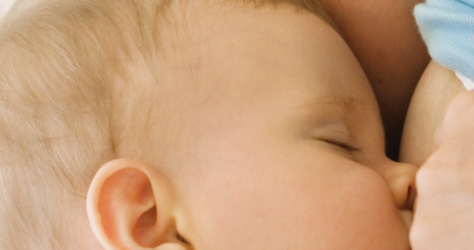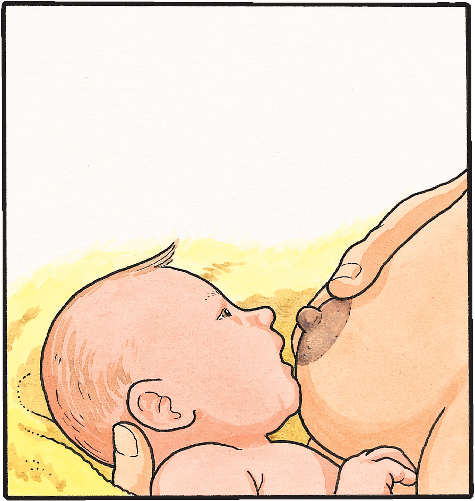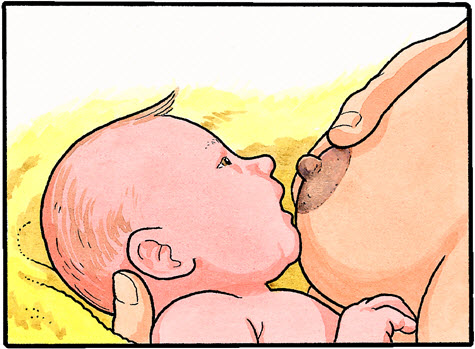The best breastfeeding positions for you and your baby
It’s really important you find the right position when you’re breastfeeding. It’ll help your baby latch on and feed properly, while also stopping your nipples from hurting, and taking the strain off your neck and back too. You might enjoy breastfeeding lying down, sitting in a chair or even ‘koala-style’ - all that matters is that it works for you both.
At a glance
- Finding the right position can help to feed properly
- It can be tricky to begin with, but will get easier
- If you're struggling, ask your health visitor or midwife for help

Finding the best positions for breastfeeding
Breastfeeding can be tricky at first - you and your baby are brand new to it, and chances are you’re pretty tired too. So check out the best positions and helpful tips below, and keep asking your midwife or a breastfeeding counsellor for help until you’re happy it’s all going well.
Top positions for breastfeeding
You’ll probably end up feeding your baby in many different places - from sitting in your local cafe, to cuddled up in bed – so you might want to mix it up a bit when it comes to positions. Here’s the low-down on the most popular ones.
Sitting in a chair – cradling the baby on your arm
In this well-known position, your baby lies across your lap, with their head resting on the arm that’s closest to the breast they’re feeding from.
Sitting in a chair – your hands on their back
This is similar, but this time you’re supporting them with the opposite arm to the breast they’re feeding from.
Reclining
This is a nice relaxing position where you’re reclining back on a sofa while your baby lies across your stomach or shoulder.
Underarm (also known as ‘rugby ball’)
Your baby is tucked under your arm for support, with their legs pointing behind you, resting their body and legs on cushions at your side and behind you.
You can support their shoulders and neck using the hand closest to the breast you’re feeding from - or rest them on extra pillows. This position is great for feeding twins as each baby has their own space and personal cushion.
Breastfeeding lying down
You lie on your side, resting your head on a pillow, with your baby tucked in close to your body. You can then guide them to your breast, while carefully supporting them with your free hand.
If it helps, try supporting your back with a pillow placed behind you. Similarly, a thin pillow or folded towel under your rib cage can lift your body slightly – helpful if you have large boobs.
If you've had a caesarean or need to stay in bed, breastfeeding lying down can really help you get some rest.
Koala hold – upright breastfeeding position
This cute-sounding position is probably better with bigger babies - you support your baby while they’re sitting upright on your knee, facing you.
Top tips for breastfeeding positions:
As well as choosing a good position, you can also try a few techniques to help your baby feed better:
Straight line - it helps to hold your baby really close to you, with their whole body facing towards you and their back and head in a straight line.

Nose to nipple - if you line up their nose so it’s level with your nipple, they’ll have to tilt their head back slightly in order to get a good ‘mouthful’. Make sure they’re facing your nipple – they shouldn't have to turn their head.

Chin first - your baby will tilt their head back and come to you chin first. They should take a large mouthful of breast, with your nipple facing towards the roof of their mouth.
Bring baby to you - lift your baby to your breast or let them attach themselves, rather than leaning over them. (This is much kinder on your back too.)
Keep things calm - holding them against you, talking to them and wrapping them securely in a towel or shawl is all very calming. As your baby grows, they might like having their hands free to touch and stroke your breast. (Cute!)

Get ready – once your baby is feeding they won’t want to move, so scoop up everything you need first, like a big glass of water and snack for you, tissues or muslins.
Get comfy – in the early days you may find cushions, special breastfeeding pillows and other supports help support your baby’s weight, taking the strain off your neck and back. Your baby may be tiny, but anything gets heavy if you hold it for long enough!
What position is best for expressing?
Just like learning to breastfeed and getting baby latched on, you need to learn how to express correctly. An important thing to remember is to be patient, and don’t expect to become an ‘expert expresser’ immediately.
Following a routine can help stimulate a good milk flow. So set yourself a fixed time of the day to pump, so that your body can prepare for the extra demand on your milk supply.
When you begin to pump, hold the breast shield from your pump set between your thumb and index finger. Use your palm and the other fingers to support your breast. This position can help maintain a good seal between the breast shield and the breast and avoids pushing the edges of the breast shield into your breast tissue, which can cause blocked milk ducts.
As with all baby products, there are a lot on the market to choose from. Ameda’s Purely Yours Electric Breast Pump is a good option to consider as it has a lot of features that work together to make pumping your milk easier.
It allows you to have consistent suction for single and double pumping and a variety of options to help you find the best settings for you. These settings can be set into the pump so you don’t need to adjust every time you’re ready to express.
The pump is designed for efficiency to make it as straightforward process as possible. There are two bottle holders so if you choose to double pump, you can fill two bottles at the same time.
It’s advisable to only pump for 60 minutes in one go and this pump will alert you to this as it automatically shuts-off after 60 minutes.